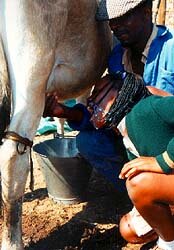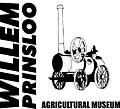| Dressing of leather |
Winter was always slaughtering time on a traditional farm. At this time, the farmer would go hunting, or he would slaughter some of his cattle for meat.
He would skin the animal and then rub coarse salt into the raw hide. The skin would then be rolled up and left under the tree for about three days for the salt to melt into the skin. This prevents the skin from cracking when it is prepared later.
The skin is put into a container together with water and lime. It is left there for one to two weeks, depending on how hot it is. When the skins are taken out afterwards, the hair is loose and is rubbed off with a knife or a sharp instrument.
The skin is cut, using a sharp knife, in a spiral from the inside to the outside, so that a long thin strip of skin is available to work with. Quite a few of the strips are taken and their ends tied together and then thrown over the branch of a tree and tied to a dressing-stone, which in turn is secured to a piece of wood.
By pushing a dressingpole into the opening between the piece of wood and the dressingstone, the riems are wound around and around. When they are wound so tight that they start knotting at the top, the dressingpole is pulled out and the riems unwind. A bit is rewound and when they stop for just a moment before turning back, the dressingpole is pushed back.
The breying of the riems takes between three to six days, depending on how long they are dressed each day. The farmer took them off every second day to rub animal fat into them to prevent them from drying out and cracking.
|
| Riems |
The skin of wild and domesticated animals was tanned and dressed by men in the pioneering days.
1. How skins are dressed
When skins are dressed the hair is not removed. The skin is softened and made more usable. Initially, it is washed to remove all traces of blood. It is then covered with a thick layer of salt and once again left in a cool place for two weeks. The skin is stretched with the inside up and rubbed with a brick or with fine sandstone to remove flesh. The skin is then dressed by hand by rubbing and folding it. Dressed skins were used as mats and for clothing.
2. How skins are tanned
In order to remove hair from skin it is tanned. The bergbas or elandswortel was traditionally used for tanning, which took about six weeks.
3. How riems are made
Riems are made by using a sharp knife to cut narrow strips from a dressed skin, starting at its outer edge and working towards the centre. To dress riems, a strong overhanging branch from which the riems will be hung, is selected. A piece of bent wood is tied to a dressing stone. The riems are plaited through it and the ends tied together. The riems are wound up by a skin dresser holding a stick in the curve of the wood and by walking in circles - first one way and then the other.
When the stick is removed, the riems unwind. The process may last as long as five or six days and sometimes longer.
Riems were used for the same purposes that ropes and chains are currently used on farms.
|
| Milking of cows |
 There are six different breeds of cattle on the farm. There are six different breeds of cattle on the farm.
The cows used for milking are:
i) The Jersey - a small, brown cow with milk that is rich in cream
ii) The Friesland is the most popular breed in the country that can produce up to 13 000 liters of milk during the lactation period
Other breeds:
i) The Drakensberger - a black breed also known as Uys cattle.
ii) The Afrikaner breed - big, reddish-brown animals used for transport
iii) The Nguni - Sanga cattle, which came from the east coast of Africa.
iv) Bonsmaras - a brown reddish breed.
For the first five days after the birth of a calf the cow's milk is not fit for human consumption. This milk is called colostrum and it is needed to build immunity against sickness in the calf.
The first step in milking is of course to wash the udder and the teats with soap and water. After that an ointment is rubbed on the teats to make them slippery and also to keep them from cracking.
Mastitis is a sickness which can, for instance, be caused by a bump on the udder. When a cow suffers from this, milk must not be used by humans and therefore the mastitis test is done daily, by milking into a cup through a strainer. Mastitis causes grain in the milk. If the strainer is clear, one knows the milk is fit to drink.
|
| Sheep |
The Willem Prinsloo Museum has a fine collection of early domesticated indigerous sheep - all known for their hardiness, disease tolerance and fertility, viz the Namaqua Afrikaner, Blinkhaar Ronderib Afrikaner, Steekhaar Ronderib Afrikaner, Black, Skilder and Redhead Persians, Pedi Zulu, Van Rooy and Damara. |
| Inspanning oxen |
In order to have a number of oxen pull as one team, they must be `inspanned' or yoked together.
The round pole or yoke is put over the head of the ox - two yokepins, one on either side of the head, holding the head in position and the "strop" or strap underneath preventing the ox from pulling out.
Oxen are always inspanned in the same way - the Afrikaner oxen in front and the Drakensbergers at the back.
The oxen have names and you will notice that the men working with the animals are always talking to them.
The team is now hitched to a one-shear plough.
Three people are needed for ploughing - the one in front is the leader `touleier', then there is the ploughman and the driver is the one who cracks the whip.
Of course the driver never touches the oxen with the whip; the mere crack of the whip is enough for the animals to pull either the plough or wagon.
|
| The separator |
Before the separator was developed it was a very tedious task to separate cream from milk.
Milk was poured into big flat dishes to cool in the `milk-rondavel'. Because cream is lighter than milk it rose to the surface and was then skimmed from the top with a spoon.
This task is done much more efficiently by the separator, which also operates on the principle that cream is lighter than milk.
Full-cream milk is poured through cheesecloth to keep back any particles of dust or grass which may have fallen into the milk.
When the handle is turned the capsule is brought into motion. Inside the capsule there are 18 discs that can turn at a speed of 7 000 revolutions per minute while the milk flows over it.
The lighter part, butterfat or cream, rises to the surface and flows through the top spout.
The skimmed milk flows through the bottom spout. Skimmed milk is very wholesome to drink - it contains all the nutrients of milk except the fatty part.
|
| Candles |
To make candles the fat used must be clean (pure) and hard.
The kidneys of cattle and other big animals such as kudu are protected by a thick layer of fat, which is hard and white and ideal for the making of candles. This fat is melted in a pot.
Wicks were made by tearing old sheets or pillowcases into strips. These strips were sometimes soaked in saltwater because it was believed that candles burnt longer and gave a brighter light if that was done.
The moulds were brought from the Cape by the Voortrekkers.
The wick is pulled through the mould and knotted at the bottom to keep the melted fat from running out. It is anchored at the top by a stick which is also used to twist the linen strip, so that it becomes round like a piece of string.
The mould is filled with fat and left to set.
To take the candle out the knot is twisted off and the candle dipped into hot water.
|
| Baking bread |
Long ago, a housewife had to bake bread for her family because there were no shops where she could simply buy a loaf. Flour was kept in skin bags, and a bakkis (baking trough) was often used for kneading. A bakkis is a wooden kist on four legs with a loose lid and tapered sides. After the dough was kneaded, it was left in the bakkis to rise. If the housewife did not have one, she used a baking skin or a big dish or basin.
Salt-raising yeast was often used. It was made by dissolving some salt in a bucket of warm water and sprinkling a layer of flour onto the water. A hole had to be left in the floating layer of flour, and a potato was often added. The bucket was then covered with a cloth and a hide and left overnight. When the flour had settled at the bottom of the bucket, the yeast was ready for use.
When the dough was well risen, it was kneaded down and put into the bread pans. In the meantime a fire was made in the oven. To build an oven requires skill, and to heat such an oven is a fine art. The burning coals had to be spread over the floor of the oven to heat it evenly. The housewife tested the temperature of the oven by holding her hand in the opening. If she could count to ten (but no further) without burning, the oven was ready for baking. The coals were then removed, the pans placed in the oven and the opening closed by covering it with a flat stone. Clay was used to seal any openings around the stone. After about an hour the bread was ready.
While on trek there were of course no ready-built ovens. An antheap just big enough to hold the bread pans was hollowed out. Where there were no antheaps, a hollow for the oven was made in the banks of a dry ditch or above a pool.
A home-made loaf of bread always has been, and still remains, a treat.
|
 Willem Prinsloo Agricultural Museum
Willem Prinsloo Agricultural Museum Willem Prinsloo Agricultural Museum
Willem Prinsloo Agricultural Museum